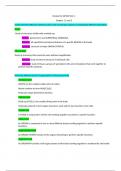Summary
Summary IAP 100 Test 1 review 2023
This document is a review for Introduction to Anatomy and Physiology (IAP 100) test 1, Ch. 1,2 and 3. These chapters consist of the introduction of anatomy and physiology, cells, and the chemical level of organization.
[Show more]



